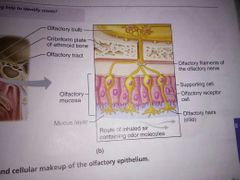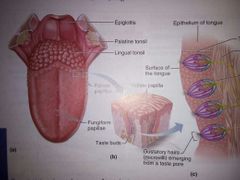![]()
![]()
![]()
Use LEFT and RIGHT arrow keys to navigate between flashcards;
Use UP and DOWN arrow keys to flip the card;
H to show hint;
A reads text to speech;
17 Cards in this Set
- Front
- Back
- 3rd side (hint)
|
Chemoreceptors |
Receptors for taste and olfaction because they respond to chemicals in solution |
|
|
|
Olfactory receptors |

Receptors for sense of smell |
|
|
|
Olfactory receptor cells |
Neurons equipped with olfactory hairs (long cilia that protrude from the nasal epithelium and bathed with mucus secreted by glands ) |
|
|
|
Olfactory filaments |

Bundle of axons of olfactory neurons that collectively make up the olfactory nerve |
|
|
|
Taxare |
Taste comes from the latin word___ which means to touch, estimate/judge |
|
|
|
Papillae |
Dorsal tongue surface is covered with small peglike projections or? |
|
|
|
Circumvallate papillae |
Taste buds are found on the sides of the large round vallate papillae or? On the top of the more numerous fungiform papillae and in the foliate papillae on the sides of the tongue |

|
|
|
Gustatory cells |
Located in the taste buds that are epithelial cells (is a specific receptor cell) that respond to chemicals dossolved in the saliva |
|
|
|
MucUs layer and olfactory hairs |
Part of the olfactory mucosa include the |
|
|
|
Gustatory hairs |
Long microvilli protrude through the taste pore; when stimulated they depolarise and impulses are transmitted to the brain |
|
|
|
Facial nerve(VII) anterior part of the tongue, Glossopharyngeal nerve and vagus nerve |
Three cranial nerves that carry taste impulses from the various taste buds to the gustatory cortex. |
|
|
|
Basal cells |
Found in the deeper regions of the taste buds they are the cells that replace when tongue is burned by hot food |
|
|
|
Sweet receptors |
Taste sensation that respond to substances such as sugar, saccharine, some amino acids and some lead salts Located on the tip of tongue |
|
|
|
Sour receptors |
A taste sensation that respond to hydrogen ions or the acidity of the solution Located on the sides of the tongue |
|
|
|
Bitter receptors |
Responds to Alkaloids Located at the back of the tongue |
|
|
|
salty receptors |
Responds to Metal ions in solution Located at the tip of the tongue |
|
|
|
Umami |
Taste discovered by the Japanese by the amino acid glutamate, respomsible for beef taste of steak and a monosodium glutamate a food additive Located on the pharynx |
|

